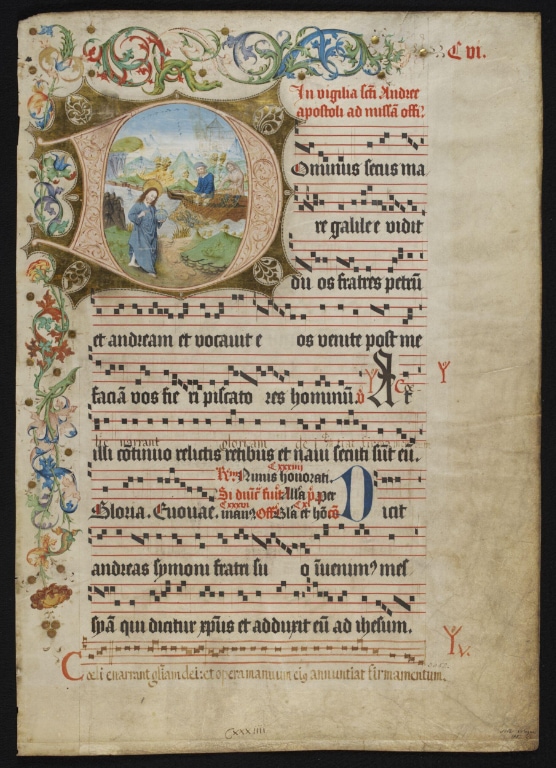Manuscript Cutting: Leaf from a Choir Book with an Historiated Initial ‘D’ showing Christ, Saint Peter and Saint Andrew

Unknown Artist
Leaf from a Choir Book with an Historiated Initial ‘D’ showing Christ, Saint Peter and Saint Andrew
Netherlands, late-15th Century
Ink and burnished gold on parchment, 505 x 360 mm
Victoria and Albert Museum (No. 3052)
This cutting is from a leaf dedicated to the Mass of Saint Andrew: he is in the initial, the rubric, and content of the song. The faint brown annotations on the leaf are from a later date and provide evidence of the continuous life of the manuscript before it was turned into a cutting.
Audio Clip & Transcript
Audio: transcription
‘Dominus secus mare Galilaeae vidit duos fratres, Petrum et Andream, et vocavit eos: Venite post me: faciam vos fieri piscatores hominum. Coeli enarrant gloriam Dei: et opera manuum ejus annuntiat firmamentum.’
‘The Lord saw two brothers, Peter and Andrew, by the seaside of Galilee, and He called them: Come ye after Me, I will make you to be fishers of men. The Heavens show forth the glory of God, and the firmament declareth the works of His hands.’
Dominus secus mare (Introit from Protus Authenticus (Modo 1)) from Octoechos Latino: El Canto Gregoriano y sus sistemas melódicos sung by Schola Antiqua (Juan Carlos Asensio Palacios)
(P) Pneuma 2002
Fragments on a page:
Many manuscript cuttings when chosen for aesthetic reasons maintain little of their original purpose, sometimes the cutting was made so precisely that nothing else on the leaf is left (see: Manuscript Cutting: Illuminated Initial ‘F’ from a Choir Book showing Saint Francis and Saint Clare – Fragments of Devotion), while at other times unwanted annotations were carefully removed (see: Historiated initial from choirbook). This leaf is very different. While the historiated initial is clearly the main subject, on the rest of the leaf we can see annotations and markings that tell the story of the leaf’s use, from its creation to collection. In the top right-hand corner we can see a bright red leaf number: ‘CVI: folio 106’. This annotation was probably made for those constructing the manuscript, to make sure that the gatherings would come together in the final product in the right order. We can also track where the cutting has been through time from other annotations. In the bottom-right corner is ‘Selb – Cologne 1857’, where the cutting must have been before the V&A acquired it in December 1863.